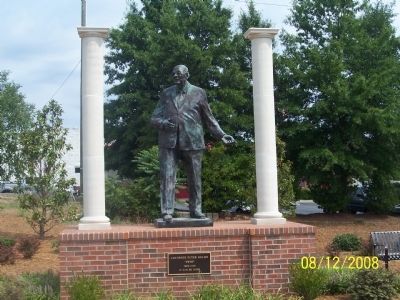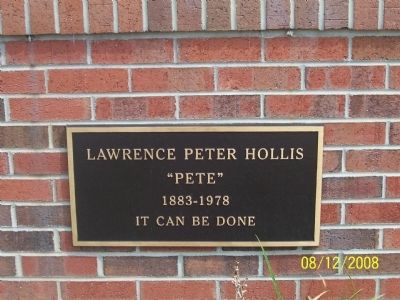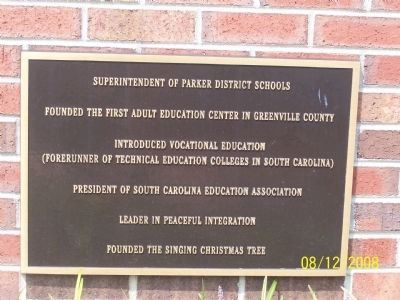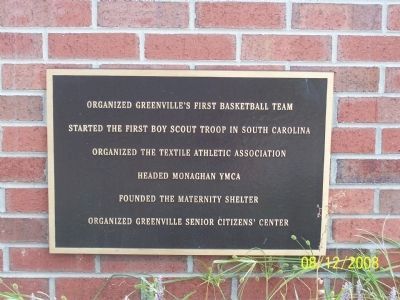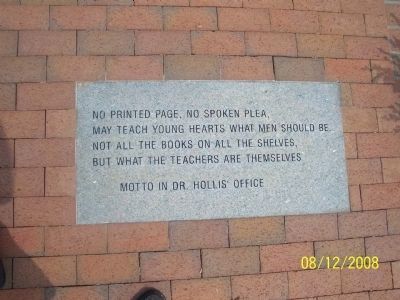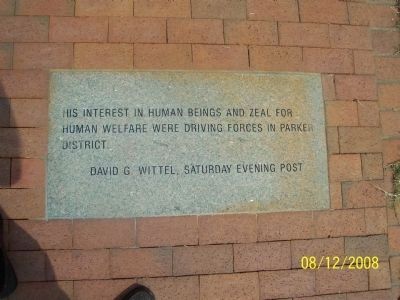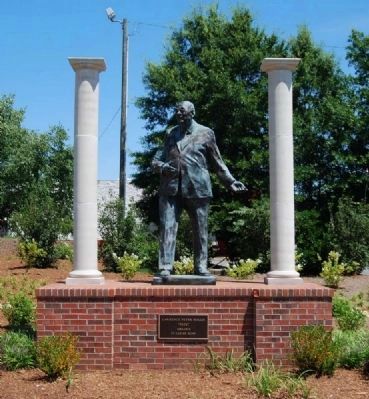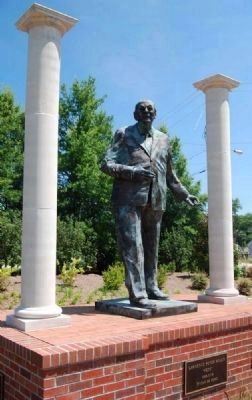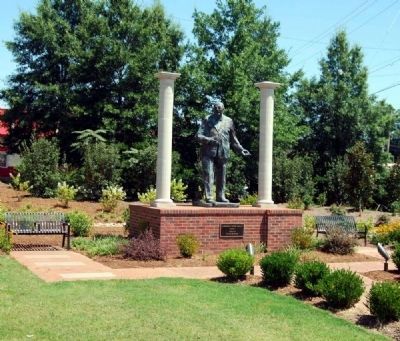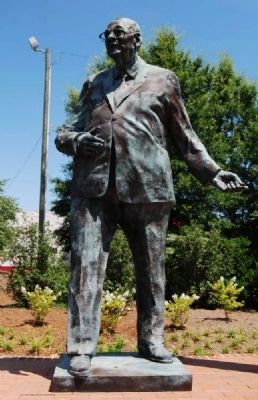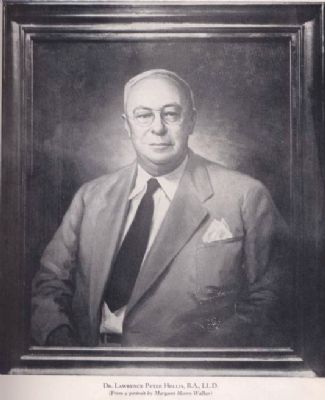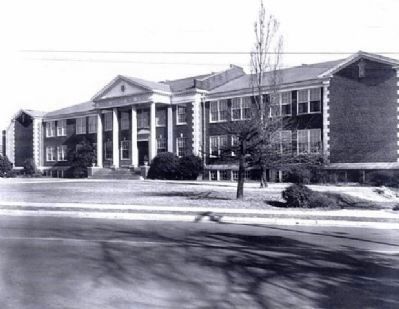Greenville in Greenville County, South Carolina — The American South (South Atlantic)
Lawrence Peter Hollis
"Pete"
It can be done
[North Face]:
Superintent of Parker District Schools.
Founded the first Adult Education Center in Greenville Coounty.
Introduced Vocational Education (Forerunner of Technical Education Colleges in South Carolina).
President of South Carolina Education Association.
Leader in peaceful integration.
Founded the Singing Christmas Tree.
[South Face]:
Organized Greenville's first basketball team.
Started the first Boy Scout Troop in South Carolina.
Headed Monagham YMCA.
Founded the Maternity Shelter.
Organized Greenville Senior Citizen's Center.
[Ground Marker]:
No printed page, no spoken plea,
may teach young hearts what men should be.
Not all the books on all the shelves,
but what the teachers are themselves.
Motto in Dr. Hollis' Office
[Ground Marker]:
His interest in human beings and zeal for human welfare were driving forces in Parker District.
David G. Wittel, Saturday Evening Post
Erected 2007 by Friends of Pete Hollis.
Topics. This historical marker is listed in these topic lists: Arts, Letters, Music • Charity & Public Work • Education • Fraternal or Sororal Organizations. A significant historical year for this entry is 1883.
Location. 34° 51.567′ N, 82° 24.294′ W. Marker is in Greenville, South Carolina, in Greenville County. Marker is at the intersection of Buncombe Street (Pete Hollis Highway) (State Highway 183) and Rutherford Street (State Highway 25) when traveling north on Buncombe Street (Pete Hollis Highway). Touch for map. Marker is in this post office area: Greenville SC 29609, United States of America. Touch for directions.
Other nearby markers. At least 10 other markers are within walking distance of this marker. General Nathanael Greene (approx. 0.2 miles away); Soldier's Rest (approx. 0.3 miles away); Whitehall (approx. 0.3 miles away); Greenville Woman's College (approx. 0.3 miles away); Lake Keowee Watershed (approx. half a mile away); Cherokee in the Upcountry / Beginnings of Greenville Water (approx. half a mile away); Reverence for Water: Feeding the Body, Feeling the Spirit (approx. half a mile away); Saluda (Poinsett) Watershed (approx. half a mile away); Table Rock Watershed (approx. half a mile away); St Mary's Catholic Church (approx. half a mile away). Touch for a list and map of all markers in Greenville.
Additional commentary.
1. 'Dr. Pete' changed Greenville community
An article by David Shi published in The Greenville News on Saturday, November 27, 2004
We stand on the shoulders of giants. Perhaps no person has had a more positive impact on modern Greenville's quality of life and community spirit than Lawrence "Pete" Hollis. The son of a Chester County cotton farmer, Hollis moved to Greenville in 1905 after graduating from the University of South Carolina, where he had served as president of the campus YMCA.
During a lifetime devoted to community service, he directed the Greenville YMCA (starting at age 21), and he helped found the Parker School District, which he served as superintendent from 1923 to 1951. He organized the first Boy Scout troop in South Carolina, and he introduced the sport of basketball to the state. Hollis was also a driving force in helping to establish the Greenville County Library, the Phillis Wheatley Center and the YWCA.
Hollis' tireless energy helped transform the lives of thousands of working-class citizens living in the Northwest Crescent, a cluster of textile mill villages forming an arc stretching from West Greenville to Berea. Warm and engaging, Pete Hollis was a common man with uncommon virtues: a caring heart, an infectious energy and a bold vision for enriching life in the mill villages.
Working
with Monaghan Mill President Thomas Parker, Hollis developed a strategy to encourage nomadic mill workers to establish roots and take ownership of their neighborhoods. He dispersed seed and fertilizer to workers, had their back yards tilled and invited a representative from the U.S. Department of Agriculture to tutor them in gardening techniques. Using funds donated by Parker, Hollis established a common pasture and provided pigs and cows — all intended to help the residents become more self-sufficient and productive.
Hollis also established clubs, teams and educational opportunities at the YMCA, which quickly became the social and cultural center for the mill villages. While attending a YMCA workshop in New York, Hollis met Dr. James Naismith, the inventor of basketball. Impressed by Naismith and the recreational opportunities that basketball offered, Hollis purchased a ball and a rulebook and brought the game to Greenville, where he organized and officiated the first basketball game played in the state. Eventually Greenville became the home of the Southern Textile Basketball Tournament, which would become a nationally renowned sporting event.
Pete Hollis instilled a sense of civic pride in the mill communities. Yards, once ragged and strewn with litter, were cleaned up and maintained. Workers donated their time and labor to build sidewalks. Neighbors joined
hands to create and nurture a public rose garden. But although living conditions improved in the mill villages, educational opportunities remained scarce.
During the early 20th century, each mill in the Northwest Crescent operated its own elementary school. The schools were often overcrowded and substandard. Because Greenville High School served only students living within the city's limits, students from the mill villages who wanted to attend had to pay $5 per month tuition plus 12 cents per day for transportation. Few could afford to so do.
In 1922 a group of mill executives, including Thomas Parker and Union Bleachery President Richard Arrington, petitioned the state Legislature to create the Parker School District. Pete Hollis was selected to organize the new district, and Parker High School opened on Nov. 25, 1924.
Hollis, affectionately called "Dr. Pete" by the teachers and students, invited famed Columbia University educator John Dewey to help the new school's teachers promote "progressive education" which encouraged students and parents to take an active role in learning. A former teacher recalls that Hollis "got rid of the screwed-down desks; he had children sitting in a circle. His method of operating was 'Let's do it.'"
Parker High School quickly became a radiant source of community pride. By the 1930s, its innovative programs and startling results were garnering international attention. Educators from Germany, New Zealand and England, as well as from across the United States, visited Parker to study Hollis's unique experiment.
A 1941 article in Reader's Digest titled "Mill Town Miracle" praised Hollis for establishing a school system that "is the center of all community life ... (that) has made the dreary (mill) towns attractive and happy places to live in, (and that has) changed a listless people into self-respecting purposeful citizens." In 1949 Look magazine named Hollis one of America's 100 finest educators. When Parker was consolidated into the school district of Greenville County in 1951, it was the largest high school in the state, enrolling more than 1,600 students.
Although Hollis retired that year at the age of 68, he continued to take an active role in community and church life. During the 1960s he helped to integrate the local schools, and in 1966 he and Virginia Uldrick, then director of the Greenville Fine Arts Center, helped organize Greenville's "Singing Christmas Tree" program.
Late in life, Hollis was showered with affection and awards. He received honorary doctoral degrees from Furman and from the University of South Carolina, and Hollis Middle School and Hollis Elementary School were named in his honor. When "Dr. Pete" died in 1978 at the age of 95, he was
the most beloved man in Greenville. His extraordinary achievements deserve perpetual appreciation.
— Submitted August 13, 2008, by Kevin W. of Stafford, Virginia.
2. Quotes about Pete Hollis
Marble plaques around the statue display quotes about Pete Hollis:
"Dr Hollis felt that music gave students a lifelong experience that they would never forget." -- Esther Rogers.
"No printed page, no spoken plea,
May teach young hearts what men should be.
Not all the books on all the shelves,
But what the teachers are themselves." -- Motto in Dr. Hollis' Office.
"Here (Parker District) is education without frills at low cost, producing fine citizens and restoring family life." -- George Kent, Reader's Digest
"Perhaps Pete Hollis has made as great or greater contribution to the well-being of South Carolina as any citizen we have ever had." -- John Holmes, Greenville Rotary Club.
"Lawrence had more influence on me than any other member of the family...he set high standards and I struggled to measure up." -- Dan Sayes Hollis, Brother.
"It is not enough to teach children. You must also teach parents." -- Dr. Pete Hollis.
"He was far ahead of his time in race relationships and spoke out courageously for fair treatment and equal opportunity." -- Gil Rowland, The Greenville News-Piedmont.
"His interest in human beings and zeal for human welfare were driving forces in Parker District." -- David G. Wittel, Saturday Evening Post.
"His appearance commanding inspire liking and respect, and his steady kindly glance and athletic energy were those of a self made American." -- Ruth A. Nicholson, Greenville Hospital System.
"Dr. Hollis has been one man that has donated his life to his fellow man. I think God for him and wish there were more like him." -- D.M. Shelton, Jr., Parker District Student.
— Submitted July 22, 2009, by Brian Scott of Anderson, South Carolina.
3. The Parker District Schools
The climax of mill paternalism was the creation of a separate school district for the textile crescent west of Greenville. At the close of World War I, each mill maintained its own elementary school, but there was no high school in the area. Some mill families paid five dollars a month in tuition to send their children to Greenville High School. In an essay written in 1924, Victoria Hunter, a student at Brandon School, indicated that many "parents were afraid to let young children go off to school. If they went to the city schools it was expensive, and people could not pay to have the children go." Most children expected to go to work as soon as they finished the sixth grade.
In 1922 the mill executives petitioned the state legislature to create the Parker School District -- named for Thomas F. Parker, who had been closely associated with mill welfare work since the beginning of the twentieth century. The new district contained 12 square miles in which twenty-five thousand operatives and their families lived. The district had about $9 million of taxable property which made it the wealthiest school district in the state. Initially, the Parker District included thirteen elementary schools and a new high school. The superintendent of the new district was Lawrence Peter Hollis -- former director of the Monaghan YMCA, the director of welfare activites of the Parker Cotton Mill Company, and since 1916 the head of the Victor-Monaghan elementary schools. Local funding would be provided by a self-imposed tax on mill property. The first year the Parker District enrolled about six thousand students and employed 130 teachers.
Under Hollis's leadership, the school district became a unifying element in the lives of the residents of the mill villages. The Parker District published a newspaper, The Joy Maker, from October 1923 to April 1924 that included school news, student essays, and articles boosting district spirit. On March 6, 1925, the paper was superseded by a weekly paper, The Parker Progress.
The centerpiece of the school district was the Parker High School, whose first principal was Ellison M. Smith. The new high school building, which cost $120,000, was designed by the J.E. Sirrine Company and was located on a hill just west of the Parker District gymnasium on the Woodside Mill village. The cornerstone was laid with appropriate ceremonies on April 18, 1924. Despite bad weather, one thousand people gathered to hear the main address by Francis Pendleton Gaines, a Furman English professor and later president of Wake Forest College and Washington and Lee University. He spoke on "The Ideal of the School" and proclaiming it "the gateway of youth, the fortress of democracy, and the temple of the spirit."
On May 26, 1924, the high school honored its first graduating class. All seventeen names appeared in the Greenville News -- Kathryn James Long, Margaret Alice Mosby, Sam A. Henson, Hazel L. Gregory, Lorene League, Edith Jane Ashmore, Allen Lawrence LaFoy, Herbert Nichols, Hester Thelma O. League, Olfrin Elizabeth Langston, Ellen Frances Jameson, Mila Russell Mauldin, Lee Coleman, Wealthy L. Hamby, John Herbert White, Irene Jones, and Fred D. Moody. Professor E.H. Henderson of Furman delivered the commencement address. E. Buford Crain, pastor of City View Baptist Church and native of Dark Corner, preached the baccalaureate sermon.
Hollis was no professional educator, but he created a vision of progressive education built on his own career of welfare work, his warm evangelical faith, and the idea of education as social amelioration from the American philosopher, John Dewey. Hollis believed that the school should fit the individual, not the individual the school. He wanted experience at the center of learning and envisioned science classes studying the environment outdoors and displaying the results at a "science fair." He enlisted the cooperation of parents in the learning process. Citizenship, music, and vocational education were essential elements of Hollis's curriculum and he never forgot the mill culture that called the Parker District into existence. A reported indicated that "book larnin' is not unduly stressed in Parker district. More emphasis is placed upon fitting the student for some trade." Textile World praised Hollis for "trying to infuse into his school district am impulse which, for what of a better term, we shall call industrial consciousness." Hollis knows that "a Ford car, movies and a radio do not compensate for the loss of the thrill which comes from doing a good job." Nevertheless, the ambitions of Parker students grew beyond the mills. As early as 1925 nearly half of the Parker graduates planned to go to college.
Hollis gathered a talented cadre of administrators and teachers. As the assistant superintendent of the elementary schools, for example, he employed Sadie Goggins. "I liked her," he said, "and I needed someone who knew about schools, so I could go around and meet the people." Lawrence G. Nelson became director of music and attracted wide attention with the Thousand Voice Choir, which sang in Textile Hall. In addition to her English classes, Mrs. Grace Heriot coached the high school Debate Club that won state and regional honors. Mrs. A.F. Geiger took great price when a member of her civics class was chosen as a page by U.S. Senator Ellison D. Smith. The student, Wayne Oates, later became a renowned pastoral psychologist and a professor at the Southern Baptist Theological Seminary.
Hollis was a strong advocate of adult literacy. In the Parker District, there were an estimated fourteen hundred people over the age of ten who could not write their names. He challenged each of the 140 teachers to teach ten persons in a single week in November 1923. Adult schools became a regular feature in the Parker District. On March 15, 1924, for example, Hollis presided over the closing banquet of the adult schools at Brandon Methodist Church. The main speakers were Brown Mahon, vice president of Judson Mills, and Wil Lou Gray, state supervisor of adult schools. The following year, in the 1925-1926
session, Greenville County led the state in adult school work.
The program of progressive education in the Parker District brought widespread recognition to Greenville. Educators and journalists from across the United States came to observe in the schools, as well as visitors from Europe, South America, and New Zealand. In August 1941 George Kent's article, "Mill Town Miracle," appeared in the educational journal, School and Society, and was reprinted in The Reader's Digest. In 1949 Hollis was the only individual from the southeast included in a survey of one hundred outstanding educators by Look Magazine.
— Submitted July 22, 2009, by Brian Scott of Anderson, South Carolina.
Credits. This page was last revised on December 13, 2019. It was originally submitted on August 12, 2008, by M. L. 'Mitch' Gambrell of Taylors, South Carolina. This page has been viewed 3,743 times since then and 68 times this year. Photos: 1. submitted on August 12, 2008, by M. L. 'Mitch' Gambrell of Taylors, South Carolina. 2, 3, 4, 5, 6. submitted on August 13, 2008, by M. L. 'Mitch' Gambrell of Taylors, South Carolina. 7, 8, 9, 10. submitted on July 22, 2009, by Brian Scott of Anderson, South Carolina. 11. submitted on August 13, 2008, by Kevin W. of Stafford, Virginia. 12. submitted on July 23, 2009, by Brian Scott of Anderson, South Carolina. • Kevin W. was the editor who published this page.
